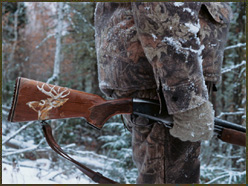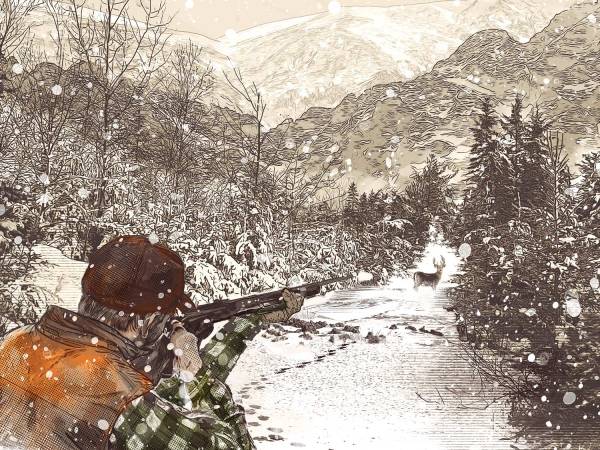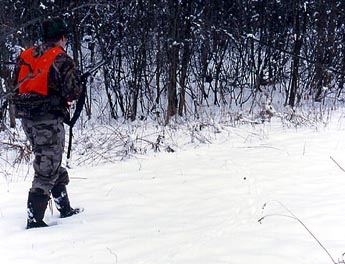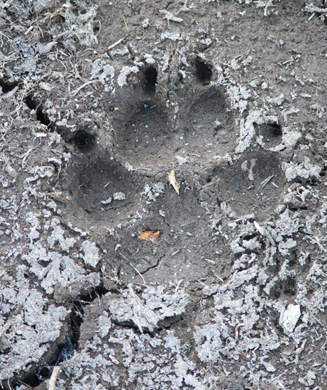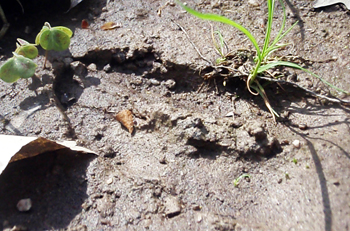Perhaps the purest form of deer hunting is tracking. To the uninformed, tracking simply means finding a buck’s hoofprints and following them until you shoot the deer. In reality, tracking pits your hunting skills, muscles, hearing and eyesight against a whitetail buck’s superior senses. To succeed at this battle of wits you need a veteran hunter’s knowledge of buck behavior and a sound understanding of how to read a track. The Benoit family of northern Vermont has generously agreed to get you started.
The Benoits have helped to elevate the art of tracking whitetail deer to its current pinnacle. Brothers Lanny, Lane and Shane continue this family tradition, passed on to them by their well-known father, Larry Benoit. The brothers are three of the best in the world at this hunting style. Here is a boiled-down, step-by-step lesson in how they track bucks.
** Finding a Buck**
When it comes to locating big bucks, most hunters search in too small an area, explains Shane, the youngest Benoit brother. When scouting for big bucks in large areas of wilderness, you have to cover a lot of ground. You need a truck you’re not afraid to trash and a willingness to go where no hunter has gone before. You have to get into places where the big bucks roam or to where they have relocated, if hunting and vehicle pressure have pushed them off the roads. Getting there can be hard on a vehicle and on a hunter. You need a truck that can crash through brush and drive across streams without getting stuck in the mud. The family’s new $40,000 SUV might not be the best choice.
Shane advises, “Burn a little shoe leather [BRACKET “or in this case, boot rubber”] scouting. Sometimes you need to go to places where you can’t drive and where others are not willing to hike. You’ll need to cover a lot of country, so plan on walking, not hunting. Take your rifle with you, of course, since there’s always the possibility of a random buck sighting, but if you’re sneaking along like you’re hunting, you won’t cover enough ground fast enough. Cover the ground, find the fresh track and then follow the deer.”
Lanny, the oldest of the Benoit brothers, is more explicit in his choice of hunting locations. “In the North Country, deer need to have good winter habitat,” he says. “The deer for miles around will depend on a comparatively small and concentrated winter yarding area to make it through the tough Northern winter.
“I like to hunt on big mountains where most hunters won’t go, but often there isn’t suitable winter habitat close enough, so these areas don’t hold a lot of deer. To find the more productive areas, I look first for winter yards, then for big mountains. Deer may not be using these yards during hunting season, but they won’t be too far from them, particularly during the end of deer season.”
The middle brother, Lane, adds, “Don’t overlook inaccessible places that might hold mature bucks, like big swamps, mountaintops, closed roads and other places that are hard to get to. If a deer can walk there, so can you.”
Reading Hoofprints
If your goal is to shoot a trophy, the only track you really need to identify is that of a big buck. A mature northern whitetail buck is the biggest deer in the woods. He is twice the weight of the average doe. He has big feet and a long stride. He is wide through the chest, so his front feet are placed farther apart than those of any other deer. He is heavier, so his track is deeper than that of other deer. He walks flat-footed, like an overweight man.
The width of the track is as important as the length. As a general rule, a wide foot indicates a big buck. The Benoits use a Remington 180-grain roundnose .30/06 Springfield cartridge as a guideline. This round is about 31/8 inches long. Most bucks big enough for the Benoits to follow leave tracks at least 3 inches wide; the best measure closer to 3¼ inches. Lny is fussy; he might look for days for an exceptionally big track before heading into the woods on the trail. That’s why his average dressed weight for bucks in the past decade exceeds 240 pounds. The tracks that get him acting like a bird dog with a nose full of scent are wider than 3¼ inches.
These guidelines will give you enough information to decide whether a track is worth further investigation. Following the track will provide more clues about the deer. If a deer avoids passing through thick brush or under limbs, it might be because he has a large set of antlers. Also, if the deer steps slightly to the side when passing close by a tree, it usually indicates a wide rack. If it makes a scrape, rubs a tree or leaves its antler imprint in the snow as it feeds, you can rest assured that you’re following a buck.
Aging a Track
This is a tough one to explain in print-it takes a lot of experience and a good measure of common sense to judge the age of tracks. Many factors affect how a track ages, including temperature, humidity, precipitation, wind and sunlight. No two situations are exactly alike. Aging tracks accurately is an acquired art that can only come from examining a lot of tracks under a wide variety of conditions.
If it’s snowing, you can judge the track by how much snow has filled it in. When snow is falling hard, the track can fill in quickly.
You can be certain that a track was made after the last snow. If that was recent, you have closed the gap, but if it hasn’t snowed in several days, the information is not much help. Beyond that, it becomes more complicated.
Consider the current weather conditions and the conditions for the past several hours and days. Is the track frozen? Have the sharp definitions melted or eroded? Sunlight and wind can cause a track to degrade, even in very cold weather.
Compare your boot track to the buck’s track. Does this deer track look like it was made when the snow conditions were the same as they are now? If the conditions were different in any way, think back to when it might have been made.
Even if the track was made under different snow conditions, it’s not necessarily too old to follow; it might have been only a few hours ago. If it was made at dawn by a tired buck heading to bed, it might well be a viable track to follow, even if it is several hours old. But if the track is heading downhill, away from the mountaintop bedding areas, there’s a good chance that the buck is rested and on the prowl. Unless he’s been distracted by a hot doe, he has a head start of several hours and is probably not worth trying to catch.
Trailing a Buck
A lot of hunters get mesmerized by the track or are so afraid they’ll lose it they don’t take their eyes off the ground. They walk with their heads down and bump the buck without getting a shot. Remember, the main point is not to follow the track, but to shoot the buck. You need to see the deer to shoot it.
When you’re following the trail, use your peripheral vision to see the track. Of course, sometimes you’ll need to look directly at it to sort things out, but when it’s clear and evident, you should glance at the track only now and then, watching it most of the time out of the corner of your eye. Keep your eyes constantly sweeping back and forth ahead of you, looking for the deer.
Look at the track as far ahead as possible, then walk to that point without checking the ground again. If you lose the track once in a while so that you have to stop and sort things out, often by back-tracking, you are probably balancing everything just about right. Lanny explains, “Most hunters move so slowly they’ll never catch up with the buck. The key is to read the sign so that you know when to move fast and when to slow down. If the buck is very close and bedded, you want to slow down to the ‘death creep’ [BRACKET “a Benoitism for sneaking along very slowly and quietly”] before you blunder into him and ruin any chance for a shot. But if the buck is traveling, you have to move fast.”
**Going for the Kill **
“Usually a buck will hear you coming,” Lanny says. “One of the mistakes that people make at this point is moving too slowly. That gives the deer time to get nervous. It’s better to keep moving at a fast pace. If you slow down, the deer has too much time to think about it and will probably run. If you move fast enough, a buck may wait to see what you are and you could get a shot.”
The death creep is only good if the deer doesn’t know you’re there. It’s meant to surprise a buck that isn’t aware of you. But if that deer has already heard you coming, you won’t get him with the death creep. “It’s like when you’re driving down the road,” explains Lanny. “Those deer can hear you coming for a long time before they see your truck, but a lot of times they wait until they see you or even until you stop before they run away. It’s the same when you’re tracking bucks. Usually they’re going to hear you, but if you just keep going, they may wait long enough for a shot. Going into the death creep in this situation is a lot like stopping the truck. It’s a change, and to them that signifies danger.
“Probably eighty-five percent of the bucks I have shot, I just walked up on and shot,” says Lanny. “But to do this, you have to be watching for the deer, and when you do see the buck, you can’t fool around. Shoot fast and hope his antlers are as good as you expected from the sign along the track.”
_This article was taken in part from Bryce M. Towsley’s new book, Benoit Bucks, published by Krause. Copies signed by Towsley and the Benoit Brothers are available for $29.95, plus $4.95 shipping and handling. Send check or money order to The Outside Connection, Inc., 58 Sonia Lane, North Clarendon, VT 05759._p’ [BRACKET “a Benoitism for sneaking along very slowly and quietly”] before you blunder into him and ruin any chance for a shot. But if the buck is traveling, you have to move fast.”
**Going for the Kill **
“Usually a buck will hear you coming,” Lanny says. “One of the mistakes that people make at this point is moving too slowly. That gives the deer time to get nervous. It’s better to keep moving at a fast pace. If you slow down, the deer has too much time to think about it and will probably run. If you move fast enough, a buck may wait to see what you are and you could get a shot.”
The death creep is only good if the deer doesn’t know you’re there. It’s meant to surprise a buck that isn’t aware of you. But if that deer has already heard you coming, you won’t get him with the death creep. “It’s like when you’re driving down the road,” explains Lanny. “Those deer can hear you coming for a long time before they see your truck, but a lot of times they wait until they see you or even until you stop before they run away. It’s the same when you’re tracking bucks. Usually they’re going to hear you, but if you just keep going, they may wait long enough for a shot. Going into the death creep in this situation is a lot like stopping the truck. It’s a change, and to them that signifies danger.
“Probably eighty-five percent of the bucks I have shot, I just walked up on and shot,” says Lanny. “But to do this, you have to be watching for the deer, and when you do see the buck, you can’t fool around. Shoot fast and hope his antlers are as good as you expected from the sign along the track.”
This article was taken in part from Bryce M. Towsley’s new book, Benoit Bucks, published by Krause. Copies signed by Towsley and the Benoit Brothers are available for $29.95, plus $4.95 shipping and handling. Send check or money order to The Outside Connection, Inc., 58 Sonia Lane, North Clarendon, VT 05759.
